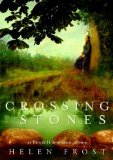
Reviewed April 12, 2010.
Frances Foster Books (Farrar, Straus and Giroux), New York, 2009. 184 pages.
Crossing Stones is a novel in verse about two families who live across a creek from each other during World War I. The book is masterfully and beautifully written. Unfortunately, I'm not a big fan of verse novels. Just hearing the thoughts of the characters from the start, it's harder for me to picture the characters and the setting. Still, once I got going, I found this to be a powerful and moving story.
Both the families that live across the creek have a brother and a sister. Frank and Emma live on one side, and Ollie and Muriel live on the other. Frank loves Muriel, and Ollie loves Emma, but when World War I starts, Frank goes off to war, and Ollie soon follows, even though he's only sixteen.
Muriel's not a fan of the war, like her Aunt Vera, a suffragette. But not being happy about the war is considered unpatriotic, and women are told their place is in the home.
This book includes war, the flu epidemic, the battle for women's rights, and the day-to-day struggles of farm chores that must go on even when the men and boys have gone to war.
I should have heeded the advice of our local Kidlit Book Club leader and read the "Notes on the Form" at the back of the book first. Helen Frost did something innovative and symbolic. She writes the poems in the voices of Muriel, Emma, and Ollie. Muriel's poems are written in free style, in the shape of a rushing creek "flowing over the stones as it pushes against its banks" just as Muriel is pushing against the constraints of her society and time.
Emma's and Ollie's poems are written to make the shapes of stones. The author explains:
I "painted" them to look round and smooth, each with a slightly different shape, like real stones. They are "cupped-hand sonnets," fourteen-line poems in which the first line rhymes with the last line, the second line rhymes with the second-to-last, and so on, so that the seventh and eight lines rhyme with each other at the poem's center. In Ollie's poems the rhymes are the beginning words of each line, and in Emma's poems they are the end words.
The rhymes are so unforced, I didn't notice them at all until I read the note at the back. I was impressed when I looked back and found the rhymes, but wish I had noticed from the beginning. Helen Frost also tells us:
To give the sense of stepping from one stone to the next, I have used the middle rhyme of one sonnet as the outside rhyme of the next. You will see that the seventh and eight lines of each of Emma's poems rhyme with the first and last lines of Ollie's next poem, and the seventh and eighth lines of Ollie's poems rhyme with the first and last lines of Emma's next poem. If you have trouble finding these rhymes, remember to look on the left side of Ollie's poems, and on the right side of Emma's.
So besides writing a moving story of World War I, Helen Frost has also pulled off an impressive technical achievement.
